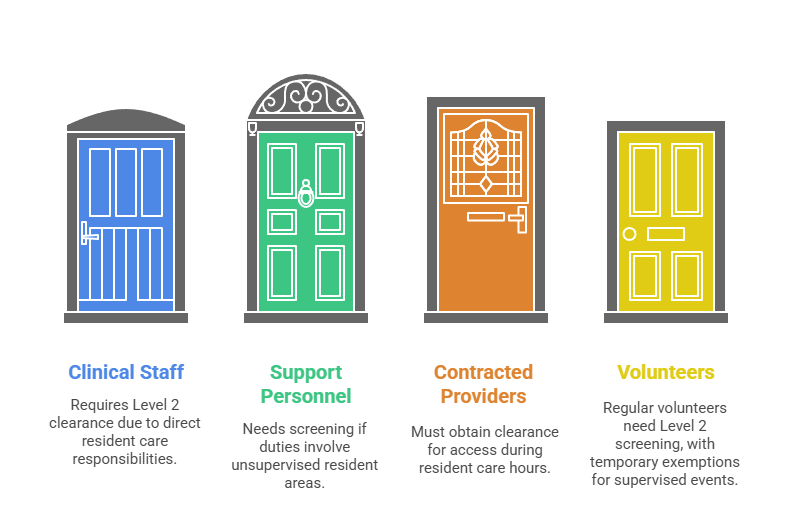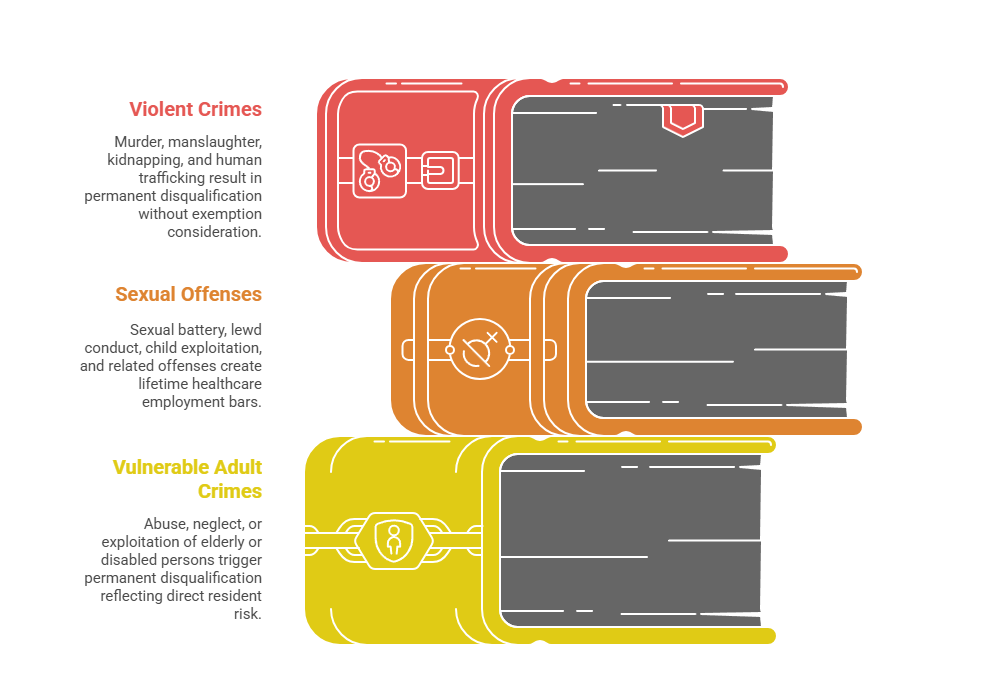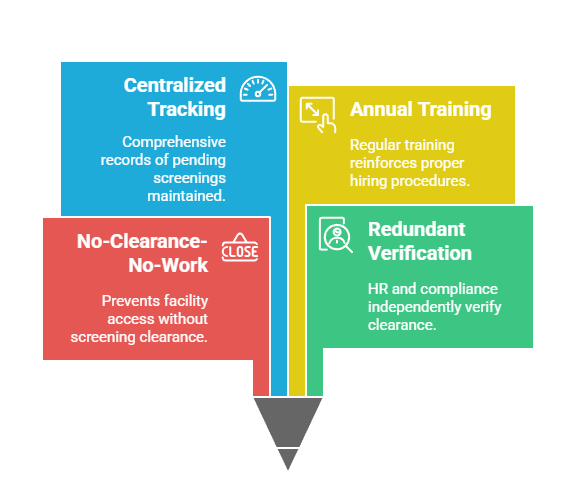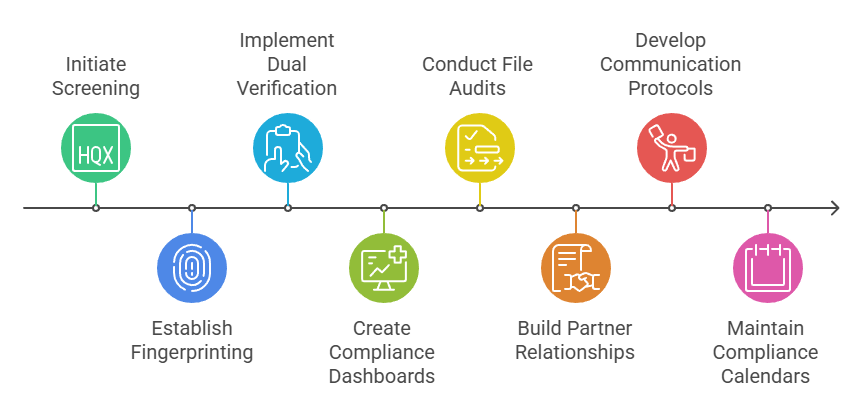Florida nursing facilities must navigate one of the nation's most stringent background check frameworks, where AHCA Level 2 screening requirements serve as the cornerstone of employee vetting protocols designed to protect vulnerable populations in long-term care settings. This comprehensive guide addresses the critical compliance mandates, processing timelines, county-specific variations, and operational strategies that nursing home administrators need to maintain regulatory adherence while avoiding penalties that can reach thousands of dollars per violation.
Key Takeaways
- AHCA Level 2 screening is mandatory for all Florida nursing facility employees with direct patient contact, combining state and national criminal history checks with abuse registry verifications.
- Standard AHCA background check processing time ranges from 5-10 business days, though expedited options exist in select counties like Pinellas and Miami-Dade.
- Florida's disqualifying offenses include 36 specific felony categories related to abuse, fraud, or controlled substances, with limited exemption pathways after designated waiting periods.
- County-specific compliance variations significantly impact screening logistics, particularly in high-density metros requiring enhanced verification protocols.
- Non-compliance penalties escalate from $500 per violation for first offenses to $5,000 for repeat violations, with potential license suspension for systematic failures.
- Conditional employment provisions allow limited pre-clearance work under direct supervision while Level 2 screenings process, but strict documentation requirements apply.
- Digital screening platforms have reduced administrative burden by 40-60% compared to paper-based systems, offering real-time status tracking.
- Annual rescreening is not required for continuous employees, but facilities must conduct new screenings for any employment gap exceeding 90 days.
Understanding Florida's AHCA Level 2 Screening Requirements
Florida's nursing facility background check compliance framework centers on Level 2 screening standards established by AHCA under Florida Statutes Chapter 408 and Chapter 435. These requirements represent the most comprehensive employee vetting process in the healthcare sector, mandating thorough criminal history checks for anyone working in licensed nursing homes and long-term care environments. The Level 2 designation signifies a deeper investigation beyond standard employment screenings, incorporating both state and federal databases to identify disqualifying criminal histories.
The screening process examines multiple criminal justice and regulatory databases simultaneously. Florida's approach requires fingerprint-based FBI checks in addition to Florida Crime Information Center (FCIC) searches, creating a dual-layer verification system. This captures both in-state and out-of-state criminal histories, addressing the transient nature of healthcare workforce mobility across state lines.
AHCA Level 2 screening requirements apply universally across Florida's 67 counties, though implementation nuances and processing infrastructure vary between metropolitan and rural jurisdictions. Understanding these foundational requirements is essential for compliance officers managing hiring workflows.
Who Must Complete Level 2 Screening
Florida law mandates Level 2 background checks for specific employee categories within nursing facilities. Direct care staff must complete screening before patient contact. Administrative personnel with unsupervised access to residents also fall under screening requirements.

- Clinical Staff: Certified nursing assistants, licensed practical nurses, registered nurses, and rehabilitation therapists require Level 2 clearance.
- Support Personnel: Food service workers, housekeepers, maintenance staff, and activities coordinators need screening when duties involve unsupervised resident areas.
- Contracted Providers: Agency nurses, therapy consultants, and medical equipment technicians must obtain clearance for facility access during resident care hours.
- Volunteers: Regular volunteers working with residents need Level 2 screening, though single-event volunteers at supervised functions may receive temporary exemptions.
Florida's interpretation of "access to residents" means even positions without direct caregiving responsibilities must undergo screening if job duties place employees in unsupervised proximity to vulnerable populations.
Components of the Level 2 Screening Process
The AHCA Level 2 screening combines five distinct verification components. Fingerprint-based searches of FBI criminal history databases form the foundation. Florida Crime Information Center records checks add state-level verification. Sexual offender and predator registry searches through FDLE complete the criminal history review.
Additional registry checks provide healthcare-specific risk identification. The Department of Children and Families abuse registry reveals individuals previously found responsible for vulnerable adult abuse, even without criminal convictions. The AHCA healthcare practitioner sanctions database identifies practitioners who lost professional licenses or faced disciplinary actions, providing insight into professional conduct history that criminal records alone might miss.
AHCA Background Check Processing Time and Workflow
Processing timelines directly impact hiring efficiency and staffing capabilities. Standard AHCA Level 2 screening processing takes 5-10 business days from fingerprint submission to final clearance notification. Facilities in counties with dedicated LiveScan fingerprinting stations—including Miami-Dade, Broward, Orange, Hillsborough, and Pinellas—typically experience faster processing than rural counties relying on ink-based fingerprint cards requiring physical mail transport.
Processing delays most frequently occur during high-volume hiring periods, particularly in summer months when seasonal staffing increases. FBI database response times occasionally extend to 14 business days when federal systems experience maintenance. Out-of-state criminal history verification adds additional processing time.
| Processing Stage | Standard Timeline | Potential Delays |
| Fingerprint capture to FDLE submission | 1-3 business days | Equipment issues, appointment availability |
| FDLE initial processing | 2-4 business days | High volume periods, print quality problems |
| FBI database search | 2-5 business days | Federal system maintenance, manual review |
| Registry verifications | 1-2 business days | Database synchronization issues |
| Final clearance notification | Same day upon completion | Email delivery, notification system lags |
Facilities can minimize processing delays through proven strategies. Establishing on-site LiveScan fingerprinting eliminates transportation delays. Partnering with AHCA-approved screening vendors offering direct electronic submission reduces manual handling errors.
Expedited Screening Options in Florida Counties
Select Florida counties offer expedited AHCA Level 2 screening pathways through enhanced partnerships between local law enforcement and state processing systems. Pinellas County operates an accelerated program for healthcare facilities with established accounts, reducing processing times to 3-5 business days. Miami-Dade's Healthcare Worker Screening Partnership provides similar expedited services for facilities meeting pre-qualification criteria.
Orange County and Hillsborough County have implemented digital fingerprint submission systems that eliminate physical card mailing delays. These systems transmit fingerprint data electronically to FDLE within hours rather than requiring multi-day postal delivery. Expedited options carry additional per-screening fees ranging from $15-35 above standard processing costs.
Conditional Employment Provisions
Florida regulations permit limited conditional employment while Level 2 screening processes, allowing facilities to address urgent staffing needs. Conditional employees may work under continuous direct supervision by a fully screened staff member during all resident contact hours. Facilities must maintain detailed supervision logs documenting the supervising employee's name, certification status, and exact hours of oversight. Conditional employment authorization extends for a maximum of 90 days from hire date.
Facilities utilizing conditional employment must implement written policies defining supervision requirements, specifying approved duties, and establishing protocols for immediate work cessation if disqualifying information emerges. AHCA surveys specifically examine conditional employment documentation, with citation rates exceeding 35% for facilities with inadequate supervision records. Many experienced administrators limit conditional employment to non-direct-care positions when possible.
Disqualifying Offenses and Exemption Pathways
Florida's framework identifies 36 specific disqualifying offense categories that permanently or temporarily bar employment in licensed long-term care facilities. These offenses fall into three classifications: crimes against vulnerable persons (abuse, neglect, exploitation), healthcare-related fraud and theft, and violent felonies. The statutory lists appear in Florida Statutes §435.04 and §408.809, with regular legislative updates.
Disqualifying offenses related to vulnerable populations carry permanent employment bars without exemption opportunities. This includes aggravated battery on an elderly person, sexual abuse of vulnerable adults, and financial exploitation of seniors. Healthcare fraud convictions including Medicaid fraud and prescription forgery trigger 15-year employment bars with limited exemption pathways after the waiting period expires.
Permanent Disqualifying Offenses
Florida law establishes permanent employment prohibitions for convictions in several serious offense categories. Murder, manslaughter, and attempted murder convictions permanently disqualify applicants regardless of time elapsed. Sexual offenses including sexual battery and lewd conduct create lifetime employment bars in all licensed healthcare facilities.

- Violent Crimes: Murder, manslaughter, kidnapping, and human trafficking result in permanent disqualification without exemption consideration.
- Sexual Offenses: Sexual battery, lewd conduct, child exploitation, and related offenses create lifetime healthcare employment bars.
- Vulnerable Adult Crimes: Abuse, neglect, or exploitation of elderly or disabled persons trigger permanent disqualification reflecting direct resident risk.
These permanent bars extend to substantially similar offenses from other states, federal jurisdictions, or foreign countries. Compliance officers must research out-of-state conviction equivalencies when applicant criminal histories reveal unfamiliar statutory names.
Time-Limited Disqualifying Offenses and Exemption Process
Florida's exemption process allows individuals with certain disqualifying offenses to seek employment clearance after designated waiting periods demonstrate rehabilitation. The process requires formal exemption applications submitted to AHCA's Background Screening Unit with comprehensive documentation including certified conviction records, character references, proof of rehabilitation program completion, and employment history. AHCA evaluates requests using a standardized scoring matrix weighing offense severity, time elapsed, rehabilitation evidence, and employment history.
Processing times typically span 90-120 days from submission to final determination. More complex cases extend beyond six months. Exemption approval rates vary significantly by offense category, with property crimes and drug possession offenses receiving favorable determinations in approximately 60-70% of applications when substantial rehabilitation evidence exists.
County-Specific Compliance Variations Across Florida

Florida's nursing facility background check compliance requirements maintain statewide consistency in statutory mandates, yet practical implementation varies significantly across the state's 67 counties based on local infrastructure and screening partnerships. High-density metropolitan counties including Miami-Dade, Broward, Palm Beach, Orange, and Hillsborough have developed sophisticated screening systems with multiple LiveScan locations and enhanced inter-agency data sharing. Rural counties often rely on limited fingerprinting locations and paper-based submission methods.
These geographic variations create operational challenges for multi-facility operators managing properties across diverse regions. Administrators must adapt screening workflows to accommodate county-specific infrastructure limitations while maintaining consistent statewide compliance.
Miami-Dade County Enhanced Verification Requirements
Miami-Dade County implements additional healthcare worker verification protocols beyond standard AHCA Level 2 screening requirements, reflecting its position as Florida's most populous jurisdiction with over 300 licensed nursing facilities. The Miami-Dade Health Department requires supplemental verification of professional licenses for clinical staff. Facilities must independently confirm nursing license status through Florida Department of Health databases and CNA registry verification through direct inquiry.
Miami-Dade's enhanced protocols emerged following high-profile credential fraud cases in healthcare settings during the early 2020s. While these constitute county health department policies rather than AHCA mandates, AHCA surveyors in Miami-Dade have incorporated verification documentation reviews into standard surveys. The county also maintains robust screening partnerships with local law enforcement, providing facilities access to expedited fingerprinting appointments.
Rural County Infrastructure Challenges and Solutions
Florida's rural counties—including Dixie, Gilchrist, Glades, Lafayette, and Liberty counties—face significant screening infrastructure limitations. Many rural counties operate single LiveScan fingerprinting locations with limited appointment availability, often requiring scheduled appointments 1-2 weeks in advance. Some lack LiveScan capabilities entirely, necessitating ink-based fingerprint card submissions that add 3-5 days to processing timelines.
- Mobile Fingerprinting Services: Vendors visit facility locations monthly or quarterly, providing convenient on-site screening for multiple applicants simultaneously.
- Law Enforcement Partnerships: Collaborations with local sheriff's offices occasionally yield access to fingerprinting equipment during designated hours.
- Regional Healthcare Collaboratives: Multi-facility coordination pools resources to justify enhanced infrastructure investments across participating organizations.
Rural facilities often maintain larger pools of conditionally employed staff compared to urban counterparts, using conditional employment provisions to address extended screening timelines while maintaining adequate staffing ratios.
Compliance Documentation and Record-Keeping Requirements
Proper documentation forms the foundation of defensible Florida nursing facility background check compliance. AHCA surveyors focus extensively on background screening documentation during inspections, with screening file deficiencies representing one of the most common citation categories. Complete screening documentation includes initial Level 2 screening results, proof of fingerprint submission, dated clearance notifications, professional license verifications, and documentation of conditional employment periods including supervision logs.
Florida regulations require facilities to maintain screening documentation for employment duration plus five years following separation. The five-year post-separation retention period allows AHCA investigators to reconstruct hiring practices when investigating complaints or adverse events involving former employees. Digital document management systems have become essential for facilities managing hundreds of employee screening files.
| Required Documentation Element | Retention Period | Common Deficiencies |
| Initial Level 2 screening results | Employment + 5 years | Missing clearance dates, incomplete registry searches |
| Fingerprint submission proof | Employment + 5 years | No submission dates, missing LiveScan receipts |
| Conditional employment logs | Employment + 5 years | Inadequate supervision documentation, missing details |
| Professional license verifications | Employment + 5 years | Outdated verifications, no independent confirmation |
| Out-of-state background checks | Employment + 5 years | Missing supplemental state checks for relocations |
Documentation quality matters as much as completeness. Screening files with missing dates, unclear supervision documentation, or gaps between hire dates and screening completion trigger surveyor scrutiny even when facilities ultimately obtained proper clearances.
Digital Screening Platform Integration
Modern digital screening platforms have revolutionized compliance management, reducing administrative burden by 40-60% compared to paper-based approaches. Cloud-based screening solutions integrate directly with AHCA's background screening clearinghouse, automatically receiving electronic clearance notifications and populating employee files. Advanced platforms offer automated compliance alerts when screening clearances near expiration or when regulatory changes affect screening requirements.
Integration with applicant tracking systems creates seamless workflows where background screenings automatically initiate upon offer acceptance. Digital platforms facilitate AHCA survey preparation by generating comprehensive screening reports with one-click access to complete documentation. Platform costs typically range from $3-8 per screening plus monthly subscription fees based on facility employee count.
Internal Audit Protocols for Ongoing Compliance
Systematic internal audit protocols transform background screening compliance from reactive survey preparation into proactive risk management. Effective audit programs include quarterly random file reviews covering 10-15% of total employees and focused reviews of all new hires from the preceding 90 days. Audit procedures should verify presence of required documentation elements and confirm proper conditional employment documentation when applicable.
Creating standardized audit checklists ensures consistency across audit cycles. Documenting audit findings in written reports with specific corrective action assignments establishes accountability for deficiency resolution. Many compliance officers schedule internal audits to conclude 60-90 days before anticipated AHCA survey dates, allowing time to correct identified deficiencies.
Penalties for Non-Compliance and Violation Categories
Florida's enforcement framework includes escalating financial penalties, conditional licensure status, and potential license revocation for severe or repeated screening failures. First-time screening violations typically result in administrative fines of $500 per affected employee. Second violations trigger $2,000-per-employee penalties. Third or subsequent violations can reach $5,000 per employee plus mandatory conditional licensure status requiring AHCA-approved corrective action plans.
AHCA categorizes screening violations into Class II, Class III, and Class IV deficiencies based on actual or potential resident harm. Employing individuals with permanent disqualifying offenses constitutes Class II violations—the most serious category indicating immediate jeopardy. Class II screening violations can trigger immediate conditional license status or emergency license suspension. Documentation deficiencies without substantive screening failures typically result in Class III or Class IV citations with monetary penalties.
The cumulative financial impact extends beyond direct AHCA penalties to include potential civil liability when inadequately screened employees harm residents. These civil claims can result in settlements or judgments reaching hundreds of thousands or millions of dollars.
Common Violation Scenarios and Prevention Strategies
Several screening violation patterns appear repeatedly across AHCA survey findings. Missing or incomplete Level 2 screening documentation represents the most common deficiency. Allowing employees to work without direct supervision before screening completion violates conditional employment requirements. Employing individuals with disqualifying offenses creates the most serious violations with highest penalty exposure.

- No-Clearance-No-Work Policies: Prevent any employee facility access until screening clearance arrives, eliminating conditional employment violations.
- Redundant Verification Systems: Both HR staff and compliance officers independently confirm clearance before employment start dates.
- Centralized Tracking Logs: Maintain comprehensive records listing all pending screenings with submission dates and expected completion timelines.
- Annual Compliance Training: All staff involved in hiring or supervision receive regular training reinforcing proper procedures.
This distributed knowledge approach prevents compliance dependencies on single individuals whose absences can create vulnerability to violations.
Responding to AHCA Survey Findings
Appropriate response to AHCA survey findings regarding background screening deficiencies significantly impacts final citation severity. Facilities should immediately investigate cited deficiencies upon surveyor notification. When surveyors identify missing documentation that actually exists, facilities can provide supplemental documentation before survey conclusion, potentially reducing citation severity.
For substantive screening violations requiring corrective actions, facilities must develop comprehensive corrective action plans addressing immediate violation correction and systemic process improvements. Effective plans include specific procedural changes, responsibility assignments with named individuals, completion timelines, and monitoring mechanisms confirming sustained correction. Facilities should consult healthcare attorneys specializing in licensure defense when facing serious violations potentially affecting licensure status.
Best Practices for Streamlined Compliance Management
Experienced Florida nursing facility administrators have developed proven strategies that transform background screening from administrative burden into efficient, reliable processes. These best practices span technology adoption, workflow optimization, staff training, and proactive relationship management with screening partners. Implementing comprehensive best practice frameworks positions facilities for consistent compliance while minimizing administrative overhead.

- Initiate Screening During Conditional Offer Stage: Begin Level 2 screening immediately upon conditional employment offer, gaining 2-3 days in processing timelines.
- Establish On-Site Fingerprinting Capabilities: Invest in LiveScan equipment to eliminate transportation barriers, reducing average time-to-clearance by 30-40%.
- Implement Dual-Verification Protocols: Require two separate staff members to independently confirm screening clearance before employment start.
- Create Visual Compliance Dashboards: Develop easily accessible displays showing all pending screenings and documentation deficiencies requiring attention.
- Conduct Quarterly File Audits: Review random employee file samples every 90 days to identify and correct documentation gaps before AHCA surveys.
- Build Screening Partner Relationships: Establish direct contacts with FDLE screening units and approved vendors for resolving processing delays.
- Develop Applicant Communication Protocols: Provide clear screening information during application and offer stages, setting realistic timeline expectations.
- Maintain Compliance Calendars: Track screening submission dates and expected completion timelines in centralized calendars with automated reminders.
These practices work synergistically to create comprehensive compliance systems that function reliably across changing personnel and operational conditions.
Screening Process Optimization for Large Facilities
Large nursing facilities with 100+ employees face unique screening challenges requiring specialized optimization approaches. These facilities benefit from dedicating specific staff members to screening coordination rather than distributing responsibilities across multiple generalist HR personnel. Screening coordinators develop specialized expertise in AHCA requirements and efficiently manage high volumes of simultaneous applications.
High-volume facilities should establish batch processing protocols where multiple applicants complete fingerprinting during scheduled weekly sessions. Creating standardized applicant screening packets with clear instructions and required documentation checklists ensures consistency across dozens or hundreds of annual hires. Large facilities also justify investments in premium screening vendor partnerships offering dedicated account management and priority processing.
Multi-Facility Operator Considerations
Healthcare organizations operating multiple Florida nursing facilities must balance standardization across locations with accommodation of county-specific variations. Corporate compliance teams should develop standardized screening policies, documentation templates, and audit protocols applicable across all properties while building flexibility for location-specific implementation details.
Multi-facility operators benefit from enterprise screening technology platforms offering centralized dashboards with facility-level drill-down capabilities. Corporate compliance officers can monitor screening status across entire portfolios while enabling facility administrators to manage local operations. Regular cross-facility compliance meetings where administrators share challenges and solutions create organizational learning opportunities that elevate compliance performance.
Conclusion
Florida nursing facility background check compliance demands sustained attention to AHCA Level 2 screening requirements, meticulous documentation practices, and proactive management of county-specific variations. Administrators who invest in robust screening systems, embrace technology solutions, and maintain comprehensive audit protocols position their facilities for regulatory success while protecting vulnerable residents. The evolving landscape of Florida healthcare regulation requires ongoing education about statutory changes and emerging best practices. By treating background screening as a foundational element of organizational safety culture, nursing facility leaders create environments where compliance excellence supports broader missions of delivering high-quality care.
Frequently Asked Questions
What is the difference between Level 1 and Level 2 background screening in Florida nursing facilities?
Level 1 screening involves only state criminal history checks through Florida Department of Law Enforcement databases, while Level 2 screening includes fingerprint-based FBI national criminal history searches, abuse registry verification, and healthcare sanctions database searches. Florida nursing facilities must conduct Level 2 screening for all employees with access to residents. The enhanced depth of Level 2 screening captures out-of-state criminal histories essential for protecting vulnerable populations.
How long is an AHCA Level 2 background screening valid in Florida?
AHCA Level 2 background screening clearances remain valid for the duration of continuous employment at a licensed facility without requiring periodic rescreening. Facilities must conduct new Level 2 screenings if an employee experiences an employment gap exceeding 90 days or transfers between separately licensed facilities. Employees maintaining continuous employment at the same facility do not require rescreening solely due to time passage.
Can nursing facilities hire employees before Level 2 screening results are received?
Florida regulations permit conditional employment under strict supervision requirements while Level 2 screening processes. Conditionally employed individuals must work under continuous direct supervision by a fully screened employee during all resident contact hours. Conditional employment authorization extends for a maximum of 90 days from hire date. Facilities must establish written conditional employment policies as AHCA surveyors specifically examine this documentation.
What criminal offenses permanently disqualify someone from nursing facility employment in Florida?
Florida law establishes permanent employment bars for convictions including murder, manslaughter, sexual battery, lewd conduct, kidnapping, human trafficking, and abuse of elderly or disabled adults. These offenses demonstrate direct threats to vulnerable residents and do not allow exemption consideration. Facilities employing individuals with permanent disqualifying offenses face immediate jeopardy citations and potential license suspension.
How much do AHCA Level 2 background checks cost in Florida?
Standard AHCA Level 2 background screening costs range from $68-85 per applicant depending on the screening vendor and fingerprinting method used. Expedited processing options in select counties add $15-35 in additional fees but reduce processing timelines by 2-4 days. Facilities using digital screening platforms may pay additional per-screening technology fees of $3-8 plus monthly subscription costs.
What happens if an employee's criminal history is discovered after they've been working at a facility?
When previously unknown disqualifying criminal history is discovered for a current employee, facilities must immediately remove the individual from resident contact pending investigation. For permanent disqualifying offenses, employment must terminate immediately with no exemption pathway. For offenses allowing exemption consideration, employees may apply for AHCA exemptions but cannot work during the 90-120 day review period.
Do certified nursing assistants need separate background checks when transferring between Florida nursing facilities?
CNAs transferring between separately licensed nursing facilities must undergo new Level 2 background screenings at the receiving facility even when recent screenings exist from previous employers. AHCA clearances attach to specific facility licenses rather than individual employees. Fingerprints remain valid in state systems, so transferred employees typically experience faster processing.
What are the penalties for Florida nursing facilities that don't properly complete employee background checks?
AHCA penalties for screening violations start at $500 per affected employee for first-time documentation deficiencies, escalating to $2,000 for second violations and $5,000 for third violations within 24-month periods. Employing individuals with disqualifying offenses constitutes Class II violations potentially triggering conditional license status or emergency suspension. Facilities also face civil liability exposure for negligent hiring claims.
Additional Resources
- Florida Agency for Health Care Administration - Background Screening Unit Official Portal
https://ahca.myflorida.com/MCHQ/Health_Facility_Regulation/Hospital_Outpatient/background.shtml - Florida Department of Law Enforcement - Criminal History Background Checks
https://www.fdle.state.fl.us/Criminal-History-Records - Florida Statutes Chapter 408 - Health Care Facility Licensure and Regulation
https://www.flsenate.gov/Laws/Statutes/2024/Chapter408 - Florida Statutes Chapter 435 - Employment Screening Standards
https://www.flsenate.gov/Laws/Statutes/2024/Chapter435 - Florida Health Care Association - Compliance Resources and Training
https://www.fhca.org - AHCA Provider Compliance Workshop Materials and Recorded Webinars
https://ahca.myflorida.com/content/download/10291/file/Provider_Compliance.pdf
